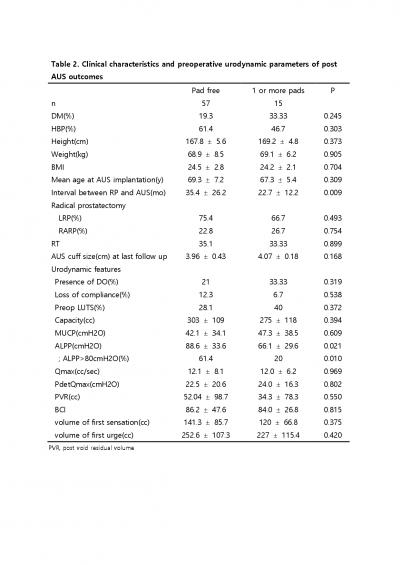|
Incontinence & Female Urology & Neurourology(구연)
|
(E-176)
|
|
|
Impact of preoperative factors on recovery of continence after Artificial Urinary Sphincter implantation in Post-Prostatectomy Incontinence |
| 가톨릭대학교 서울성모병원 비뇨의학과 |
| 신동호, 권혁재, 성재우, 허경재, 문형우, 박용현, 조혁진, 하유신, 홍성후, 이지열, 김세웅, 배웅진 |
Introduction & Objectives
The incontinence after radical prostatectomy(RP) decrease the quality of life in prostate cancer patients. The artificial urinary sphincter(AUS) is one of standard treatment for post-RP incontinence and since urodynamic study is performed widely before AUS to evaluate the causes, we analyzed the effect on parameters of the Urodynamic study before AUS in post-RP incontinence.
Methods
From april 2006 to march 2020, a total of 72 patients who underwent AUS were analyzed. The clinical features and preoperative urodynamic evaluations were correlated with treatment success using linear and logistic regression analysis. Treatment success (recovery of continence) was defined as the use of no pad during 24hrs at the end of follow up visit.
Results
Of 72 patients, 57 (79.2%) had recovery of continence and 15 (20.8%) were wearing more than 1 pad per day on the last follow-up visit. In clinical characteristics, only the Interval between RP and AUS(mo) showed statistically significant difference by 35.4 ± 26.2 in surgical success group and 22.7 ± 12.2 in surgical fail group (p=0.009). Other preoperative clinical features such as underlying disease, methods of surgery, and RT were not significantly statistically different.
In preoperative urodynamic parameters, only the ALPP showed statistically related to surgical outcomes by 88.6 ± 33.6 in success group and 66.1 ± 29.6 (P=0.021) in failure group.
Of preoperative UDS parameters, number of patients whom ALPP were higher than 80cmH2O in surgical success group was 61.4% and 20% in surgical fail group (95% confidence interval 1.612-25.11). All other preoperative UDS features including detrusor underactivity, MUCP and etc. were not statistically significant.
Conclusions
Interval between RP and AUS, and preoperative ALPP can be predictive factors for surgical outcomes of AUS. Also, a ALPP of >80cmH2O has a high degree of predictability for success of AUS surgical outcomes in post RP incontinence
|
 |
|
keywords : Post prostatectomy incontinence, Artificial urinary sphincter, Urodynamic study |
|

